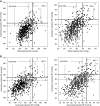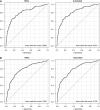Diagnostic Performance of Blood Pressure Measurement Modalities in Living Kidney Donor Candidates
- PMID: 30948455
- PMCID: PMC6500946
- DOI: 10.2215/CJN.02780218
Diagnostic Performance of Blood Pressure Measurement Modalities in Living Kidney Donor Candidates
Abstract
Background and objectives: Precise BP measurement to exclude hypertension is critical in evaluating potential living kidney donors. Ambulatory BP monitoring is considered the gold standard method for diagnosing hypertension, but it is cumbersome to perform. We sought to determine whether lower BP cutoffs using office and automated BP would reduce the rate of missed hypertension in potential living donors.
Design, setting, participants, & measurements: We measured BP in 578 prospective donors using three modalities: (1) single office BP, (2) office automated BP (average of five consecutive automated readings separated by 1 minute), and (3) ambulatory BP. Daytime ambulatory BP was considered the gold standard for diagnosing hypertension. We assessed both the Seventh Report of the Joint National Committee on Prevention, Detection, Evaluation, and Treatment of High Blood Pressure (JNC-7) and the American College of Cardiology/American Heart Association (ACC/AHA) definitions of hypertension in the cohort. Empirical thresholds of office BP and automated BP for the detection of ambulatory BP-diagnosed hypertension were derived using Youden index, which maximizes the sum of sensitivity and specificity and gives equal weight to false positive and false negative values.
Results: Hypertension was diagnosed in 90 (16%) prospective donors by JNC-7 criteria and 198 (34%) prospective donors by ACC/AHA criteria. Masked hypertension was found in 3% of the total cohort by JNC-7 using the combination of office or automated BP, and it was seen in 24% by ACC/AHA guidelines. Using Youden index, cutoffs were derived for both office and automated BP using JNC-7 (<123/82 and <120/78 mm Hg) and ACC/AHA (<119/79 and <116/76 mm Hg) definitions. Using these lower cutoffs, the sensitivity for detecting hypertension improved from 79% to 87% for JNC-7 and from 32% to 87% by ACC/AHA definition, with negative predictive values of 95% and 87%, respectively. Missed (masked) hypertension was reduced to 2% and 4% of the entire cohort by JNC-7and ACC/AHA, respectively.
Conclusions: The prevalence of hypertension was higher in living donor candidates using ACC/AHA compared JNC-7 definitions. Lower BP cutoffs in the clinic improved sensitivity and led to a low overall prevalence of missed hypertension in prospective living kidney donors.
Keywords: American Heart Association; Blood Pressure Determination; Blood Pressure Monitoring, Ambulatory; Living Donors; Masked Hypertension; Prospective Studies; blood pressure; hypertension; hypotension; kidney donation.
Copyright © 2019 by the American Society of Nephrology.
Figures




References
-
- Poggio ED, Braun WE, Davis C: The science of Stewardship: Due diligence for kidney donors and kidney function in living kidney donation--evaluation, determinants, and implications for outcomes. Clin J Am Soc Nephrol 4: 1677–1684, 2009 - PubMed
-
- Textor SC, Taler SJ, Driscoll N, Larson TS, Gloor J, Griffin M, Cosio F, Schwab T, Prieto M, Nyberg S, Ishitani M, Stegall M: Blood pressure and renal function after kidney donation from hypertensive living donors. Transplantation 78: 276–282, 2004 - PubMed
-
- Clement DL, De Buyzere ML, De Bacquer DA, de Leeuw PW, Duprez DA, Fagard RH, Gheeraert PJ, Missault LH, Braun JJ, Six RO, Van Der Niepen P, O’Brien E; Office versus Ambulatory Pressure Study Investigators : Prognostic value of ambulatory blood-pressure recordings in patients with treated hypertension. N Engl J Med 348: 2407–2415, 2003 - PubMed
-
- Hansen TW, Jeppesen J, Rasmussen S, Ibsen H, Torp-Pedersen C: Ambulatory blood pressure and mortality: A population-based study. Hypertension 45: 499–504, 2005 - PubMed
-
- Ozdemir FN, Güz G, Sezer S, Arat Z, Haberal M: Ambulatory blood pressure monitoring in potential renal transplant donors. Nephrol Dial Transplant 15: 1038–1040, 2000 - PubMed
Publication types
MeSH terms
Grants and funding
LinkOut - more resources
Full Text Sources
Medical

